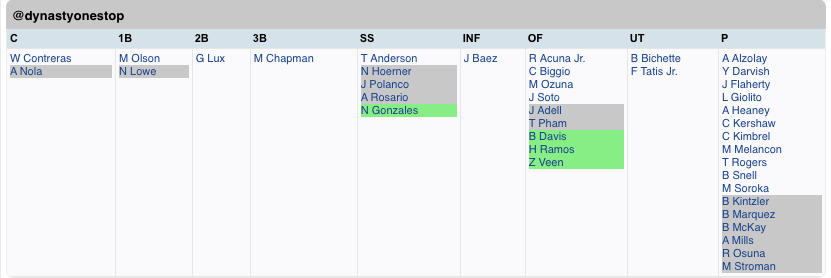Turning 3 Leagues into 1
And then there was one.
The first dynasty league I ever played in was the League of Evil dynasty league lead by FSAA. As noted in an earlier article, I was invited to this league after a simple mock draft with the two founders and took over a team in rough shape.
This league was the twin with another league that I eventually joined, and then we created a fresh dynasty league. All three of these leagues were identical in many regards. All of them were 12 team head-to-head leagues. They had the same roster sizes, the same number of keepers, the same commissioner and co-commissioner (me). The only thing they varied on were the managers, and even in that regard we had a ton of overlap.
Over the past few seasons it became clear that across all three leagues the teams that were consistently at the top were the same, the teams that were rebuilding/leaving rebuilds were the same.
This was how I did in those leagues across the years:
This led to a question: “Why are we playing three identical leagues instead of one?”
And so, an idea was born. What if there was a way to consolidate the three leagues into one league without erasing the history of the league?
I did not want to remove the hard work done over the years by these managers to get players they wanted on their teams. I did not want to erase rosters built, prospects managers were in on early, or any other work done.
And so, I hatched a scheme.
As I mentioned most of the managers were in a number of the leagues. We had 7 in all three, 4 in two of them, and a handful only in one.
So, for all the managers who wanted to hang around to consolidate (which ended up primarily being the ones who had been around the longest, which surprised no one since they had invested more in the existing rosters and the newer additions were more interested in a restart) this is what happened:
If you had 3 teams, you picked 2 of your rosters to use moving forward in the process.
If you had 2 teams – congrats those are your 2 rosters to use in the process.
If you had 1 team you were assigned another team that had the greatest overlap with your current team.
Now why does that overlap matter? I hear you cry…
Because if you had players who were on both of your rosters you could automatically have them.
Every roster got 17 “keepers” – here defined as players who you previously owned across either of your two rosters who would stay on your roster in the new single league.
So I built a spreadsheet, as I am fond of doing, that analyzed who were duplicates for each manager in the league.
This is how that looked:
Then each of these managers decided which of these players they wanted to claim before a “draft” where you could only take players who were on any of your rosters.
One interesting facet of this is that some players who may have been duplicate options on your roster may not have been on anyone’s rosters so you could choose to not “keep” them as a duplicate and still be able to add them for free later on. Moreover, some players who were not duplicates could, conceivably, not be owned by anyone else. This is mainly because not every roster across every league carried over because it was either a 3rd team someone didn’t pick as their two, a manager left, or a team was vacant. If I were to do this again, I would include those solo claim players in the original keeper list. But, for example, I was the only player with a claim on Tatis so in the draft I just waited to add him. Or, another example is that Jose Ramirez actually ended up not being eligible for anybody’s roster in the 17 round draft so he was there in the 23 round free for all draft.
Once players were chosen then we drafted up to 17 total players on each roster. The number of picks varied by how many players each team had kept. We had to monitor the draft to ensure managers only took players they were allowed to take, but using Fantrax’s great customizability made it so that every team ended with 17 players.
So next this league drafted another 23 rounds to draft up to 40-man rosters. And in the draft we needed up seeing exactly what I had hoped with this and a redistribution of talent and wealth while still allowing teams with great prospect cores to keep a number of those prospects, allowing teams with some elite players to keep some, but not all of them, and move some of the wealth, and hopefully competitive balance, around.
This is what my final roster looked like:

The players acquired in the draft:
Marcell Ozuna (via trade)
Mike Soroka
Zac Veen
Tommy Pham
Andrew Heaney
Nate Lowe
Adbert Alzolay
Nick Gonzales
Brendan McKay
Brailyn Marquez
Jorge Polanco
Nico Hoerner
Aaron Nola
Amed Rosario
Heliot Ramos
Craig Kimbrel
Mark Melancon
Taylor Rogers
Brandon Kintzler
Alec Mills
Roberto Osuna
Marcus Stroman
So in summary:
We took three leagues with managers who were largely in every league or at least two and turned it into one league
17 players on each team’s roster are players who were on their previous rosters
23 players are new players with open player pool draft of the remaining players
While the original setting up of duplicates and having people decide who to keep was a touch convoluted, it honestly went off far better than I expected, and the 12 managers in League of Evil 2.0 seem happy with the results and how it both honors the work done by these managers in the past and allows for some change and a shift in contention windows moving forward.
See all the final rosters below:
